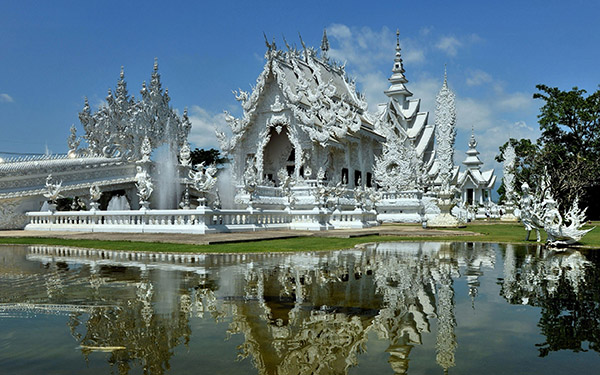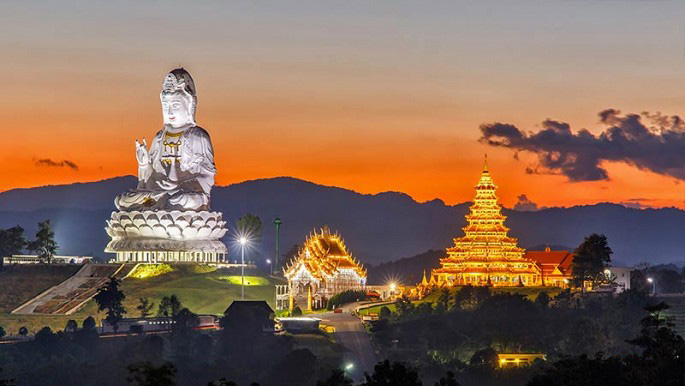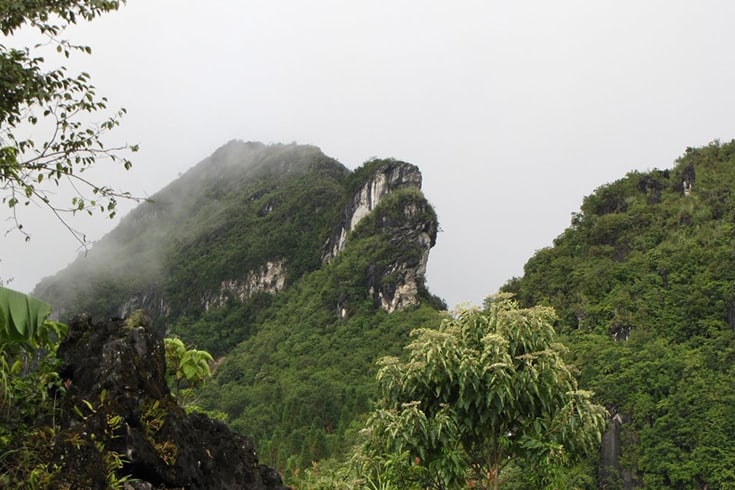What to visit in Chiangrai
Chiang Rai Province is a northernmost province of Thailand, bordered by the provinces (clockwise from the east): Phayao, Lampang, and Chiang Mai. To the north, the province shares borders with Myanmar’s Shan State as well as Laos’ Bokeo and Oudomxai provinces.
Chiang Rai has a history dating back to the 7th century, but it wasn’t until 1262 that King Meng Rai established it as the first capital of the Lanna Kingdom. Afterward, the capital of Chiang Rai merged with Chiang Mai Province, and since then, Chiang Rai has lived in the shadow of its neighboring province, although this has been beneficial for tourism.
Today, Chiang Rai is a paradise for travelers, blessed with diverse attractions provided by nature and enriched by ancient historical sites. The tourist attractions are appealing and varied, ranging from the ruins of ancient settlements and Buddhist temples to picturesque hills and beautiful villages.
Top attraction What to visit in Chiangrai
Wat Rong Khun
Wat Rong Khun, also known as the White Temple, has become a cultural symbol of Thailand. It stands as one of the most beautiful architectural wonders not only in Thailand but also globally.
Unlike traditional golden-colored temples in Thailand, Wat Rong Khun is entirely painted in a dazzling white color resembling snow. The idea behind the white color is to honor the pure wisdom of Lord Buddha. However, the temple is renowned not just for its unique color but also for its exquisite and beautiful architecture. Built using white plaster and paint, the temple’s artistically gifted Chaloemchai Khositphiphat added intricate details using small cut glass pieces, making the carvings shimmer. Influenced by and incorporating elements from Hindu and Buddhist myths, the architecture of Wat Rong Khun exudes a sense of enchantment and mystery.
]To reach this temple, visitors must cross a bridge under which lies a small hell-like scene with countless grotesque hands and faces of sinners reaching out as if trying to grasp something. Inside, there are mural paintings depicting Buddha’s stories, particularly images of Buddha meditating in peace under the protection of the Naga serpent, a distinct Thai symbol. Surrounding the temple is a park with a pond filled with fish and white sculptures designed by Chalermchai. Each sculpture represents a mythical creature with its own meaning.
Not all structures in Wat Rong Khun are white; within the temple complex, there is a stunning golden-colored building that might initially be mistaken for another temple. In reality, it’s a public restroom.
 Wat Rong Suea Ten
Wat Rong Suea Ten
Adjacent to the mesmerizing White Temple, Wat Rong Suea Ten, or the Blue Temple, also attracts tourists. Open since January 2016, this temple has become a top spot for photo enthusiasts.
Situated in Rim Kok, a district of Chiang Rai, Wat Rong Suea Ten derives its name from the village of the people who constructed it. Unlike Wat Rong Khun and the Black House Museum, Wat Rong Suea Ten remains less publicized and known.
Although construction of this temple began in 2005, it wasn’t completed until 2016. Due to its extended construction period, every detail in the temple is meticulously crafted. Every twist, every statue is intricately designed and delicately executed. Upon arrival at Wat Rong Suea Ten, visitors are greeted by walls and ceilings painted in vivid shades of green with gold accents. The green color represents Buddhist teachings, symbolizing the widespread propagation of Buddha’s wisdom across the world, akin to the vibrant blue sky.
The most distinctive feature of this temple might be its main assembly hall, where a massive white jade statue of Lord Buddha resides. The hall’s walls are adorned with exquisite murals depicting Buddha’s stories. The entire space captures visitors’ hearts, leaving them mesmerized and reluctant to depart.
Wat Phra Kaew
This is the place where the famous Emerald Buddha, a national treasure of Thailand, was discovered. Today, the temple enshrines a near-perfect replica of the renowned iconic statue.
 Wat Klang Wiang
Wat Klang Wiang
Another remarkable temple in Chiang Rai is Wat Klang Wiang, showcasing a unique and exquisite Lanna-style architecture.
Visitors to this temple will be captivated by its distinctive Lanna-style architecture. The buildings are adorned with red and white gabled roofs, reflecting the artistic and grandeur of ancient Lanna culture.
Wat Phra Singh
Wat Phra Singh, while still carrying the ancient Lanna style, distinguishes itself by its entrance area depicting the four elements: Water, Earth, Wind, and Fire, combined with mythical creatures like serpents, elephants, garudas, and lions.What to visit in Chiangrai. This attractive site immerses visitors in the magical world of Lanna art from 6 to 7 centuries ago.
Chiang Rai Clock Tower
Similar to London’s Elizabeth Tower, the Chiang Rai Clock Tower is a well-known landmark, not just in Chiang Rai but also throughout Thailand.
Resembling the Elizabeth Tower that commemorates Queen Elizabeth II’s 60-year reign, the Chiang Rai Clock Tower was constructed in 2008 to honor King Bhumibhol Adulyadej.
This tower brings a unique and magnificent style to the ancient city with its intricate golden carvings. Situated at the junction of Phaholyothin and Banpaprakan roads, visitors can’t miss the tower’s remarkable presence. The clock tower showcases the talents of Thai artists through intricate carvings.
Naval City Pillar Monument
Consisting of concentric circles of stone pillars, the Naval City Pillar represents both the universe and humans in Khmer and ancient Lanna cultures. It possesses a mysterious allure, similar to Stonehenge or the stone statues on Easter Island.
Commemorative Monument of King Mengrai
King Mengrai, the founder of Chiang Rai and Chiang Mai, ushered in a period of prosperity for the Lanna Kingdom. His monument serves as a landmark and welcomes visitors to the northern city.
Royal Villa
The royal villa in Chiang Rai was initiated by Queen Somdet Phra Srinagarindra Boromarajajonani. The villa is open to visitors and aims to improve the lives of local residents.
At the royal villa, visitors can explore key rooms and learn fascinating stories about the life of the queen. It provides insight into the queen’s activities and contributions during her time.
Oub Kham Museum
This museum showcases various Lanna artifacts, some of which are centuries old. Visitors will encounter intricate royal costumes, deity sculptures, ancient artifacts, and rare items. What to visit in Chiangrai.
Notably, Oub Kham Museum houses the golden pedestal of Chiang Tung, an exquisitely crafted wooden structure with traditional Lanna carvings and lavish gold plating. Additionally, the museum’s artificial cave is one of the most unique display areas in Thailand.
Doi Chang
Doi Chang is the largest coffee-growing area in Thailand. In addition to coffee plantations, Doi Chang’s mountaintop provides a perfect location to witness spectacular sunrises in Chiang Rai. The area also boasts various farms cultivating seasonal fruits and vegetables. The Arabica coffee produced here is highly acclaimed, with Starbucks having used coffee from this region for its blends. Experiencing Doi Chang during the cool winter months, enjoying a cup of hot coffee while watching the sunrise, is an exquisite experience.
 Chiang Rai Night Bazaar
Chiang Rai Night Bazaar
Amidst historical sites and cultural monuments lies Chiang Rai’s bustling night bazaar that comes to life when the city lights up.
Similar to Thailand’s other night markets, Chiang Rai Night Bazaar offers an exciting shopping experience for visitors, featuring fresh produce and unique souvenirs. Moreover, the bazaar is a place for meeting new people, mingling, making friends, and unwinding while exploring a different and vibrant atmosphere. What to visit in Chiangrai.
Phu Chi Fah
Translated from Thai, “Phu” means mountain, “Chi” means viewpoint, and “Fah” means sky. Hence, Phu Chi Fah is one of the most remarkable sky-viewing spots in Chiang Rai. Situated within the preserved area of the Mae Ngao National Park, spanning around 400 hectares in total.
Phu Chi Fah is a destination that challenges trekking enthusiasts, offering them the opportunity to immerse themselves in breathtaking cloudscapes and capture magnificent sunrises and sunsets in Chiang Rai. The Thais refer to the surrounding peaks as the “islands of mist,” and as the clouds disperse in the morning sunlight, visitors can enjoy a panoramic view of the Mekong River.
In summary,What to visit in Chiangrai.
Chiang Rai Province is a captivating destination where historical significance and natural beauty harmoniously coexist. Visitors can explore exquisite temples, delve into rich Lanna culture, experience the vibrant night bazaars, and immerse themselves in the breathtaking landscapes of northern Thailand. Whether admiring the artistry of Wat Rong Khun or witnessing the grandeur of Chiang Rai’s Clock Tower, the province offers a diverse range of attractions that will undoubtedly leave an indelible impression on travelers from around the world.
See more



